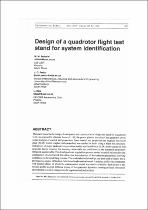JavaScript is disabled for your browser. Some features of this site may not work without it.
- ResearchSpace
- →
- Research Publications/Outputs
- →
- Journal Articles
- →
- View Item
| dc.contributor.author |
Beharie, MM

|
|
| dc.contributor.author |
Pedro, JO

|
|
| dc.contributor.author |
Dala, L

|
|
| dc.date.accessioned | 2016-08-22T11:31:37Z | |
| dc.date.available | 2016-08-22T11:31:37Z | |
| dc.date.issued | 2015 | |
| dc.identifier.citation | Beharie, MM, Pedro, JO and Dala L. 2015. Design of a quadrotor flight test stand for system identification. Aeronautical Journal, Vol 119(1214), pp 501-521 | en_US |
| dc.identifier.uri | http://aerosociety.com/News/Publications/Aero-Journal/Online/3022/Design-of-a-quadrotor-flight-test-stand-for-system-identification | |
| dc.identifier.uri | http://hdl.handle.net/10204/8724 | |
| dc.description | Copyright 2015: Cambridge University Press. Due to copyright restrictions, the attached PDF file only contains the abstract of the full text item. For access to the full text item, please consult the publisher's website. The definitive version of the work is published in the Aeronautical Journal, Vol 119(1214), pp 501-521 | en_US |
| dc.description.abstract | This paper presents the design, development and construction of a flight test stand for a quadrotor UAV. As opposed to alternate forms of UAV, the power plant in the case of the quadrotor serves a dual purpose of control and propulsion. Since control and propulsion are coupled, the power plant (BLDC motor coupled with propeller) was studied in detail using a black box structure. Extractions of motor parameters in previous studies used traditional BLDC motor equations and propeller theory however the accuracy achievable and confidence in the extracted parameters remained questionable. The developed data acquisition process served to satisfy this need by the construction of a test bench that allows for the extraction of the unknown parameters instilling confidence in the modelling process. The established relationships are then used as inputs into a developed six degree of freedom Euler based mathematical model. A mission profile was constructed with distinct phases of which the mathematical model was used to simulate. Each phase in the mission profile excited different modes of the quadrotor dynamics creating an ideal simulation environment in which changes can be implemented and studied. | en_US |
| dc.language.iso | en | en_US |
| dc.publisher | Cambridge University Press | en_US |
| dc.relation.ispartofseries | Worklist;15336/16662 | |
| dc.subject | Unmanned Aerial Vehicle | en_US |
| dc.subject | UAV | en_US |
| dc.subject | Quadrotor UAV | en_US |
| dc.subject | Quadrotor flight test stand design | en_US |
| dc.title | Design of a quadrotor flight test stand for system identification | en_US |
| dc.type | Article | en_US |
| dc.identifier.apacitation | Beharie, M., Pedro, J., & Dala, L. (2015). Design of a quadrotor flight test stand for system identification. http://hdl.handle.net/10204/8724 | en_ZA |
| dc.identifier.chicagocitation | Beharie, MM, JO Pedro, and L Dala "Design of a quadrotor flight test stand for system identification." (2015) http://hdl.handle.net/10204/8724 | en_ZA |
| dc.identifier.vancouvercitation | Beharie M, Pedro J, Dala L. Design of a quadrotor flight test stand for system identification. 2015; http://hdl.handle.net/10204/8724. | en_ZA |
| dc.identifier.ris | TY - Article AU - Beharie, MM AU - Pedro, JO AU - Dala, L AB - This paper presents the design, development and construction of a flight test stand for a quadrotor UAV. As opposed to alternate forms of UAV, the power plant in the case of the quadrotor serves a dual purpose of control and propulsion. Since control and propulsion are coupled, the power plant (BLDC motor coupled with propeller) was studied in detail using a black box structure. Extractions of motor parameters in previous studies used traditional BLDC motor equations and propeller theory however the accuracy achievable and confidence in the extracted parameters remained questionable. The developed data acquisition process served to satisfy this need by the construction of a test bench that allows for the extraction of the unknown parameters instilling confidence in the modelling process. The established relationships are then used as inputs into a developed six degree of freedom Euler based mathematical model. A mission profile was constructed with distinct phases of which the mathematical model was used to simulate. Each phase in the mission profile excited different modes of the quadrotor dynamics creating an ideal simulation environment in which changes can be implemented and studied. DA - 2015 DB - ResearchSpace DP - CSIR KW - Unmanned Aerial Vehicle KW - UAV KW - Quadrotor UAV KW - Quadrotor flight test stand design LK - https://researchspace.csir.co.za PY - 2015 T1 - Design of a quadrotor flight test stand for system identification TI - Design of a quadrotor flight test stand for system identification UR - http://hdl.handle.net/10204/8724 ER - | en_ZA |






